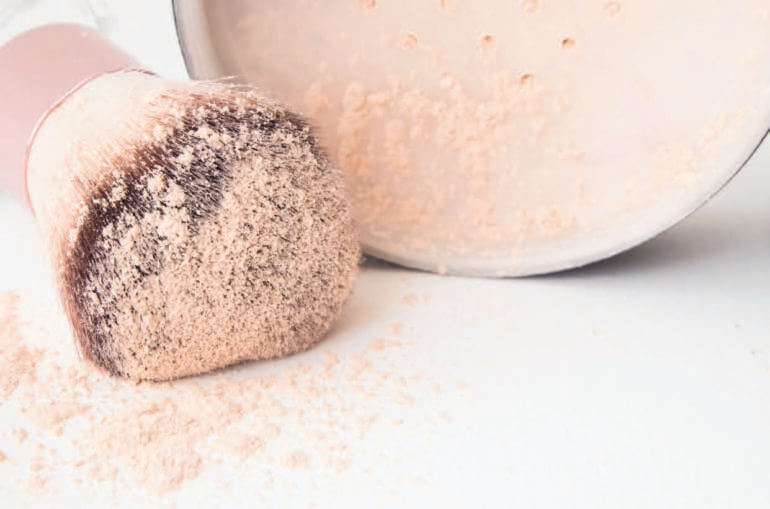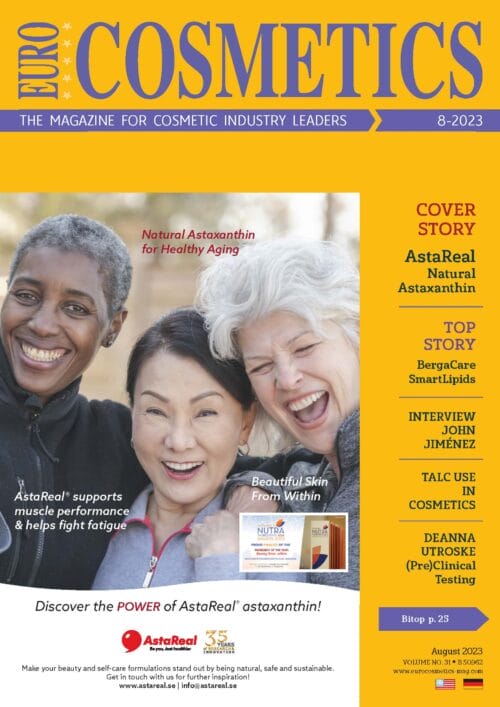
Introduction
The idea of “clean beauty” has swept across the cosmetics market, establishing a new paradigm. Messages like “free of harmful ingredients” seems to be now the standard. The focus is entirely on avoiding “suspicious ingredients” when developing cosmetic formulations, and “free-from” claims are commonplace in advertising and on product packaging. In other words, all the attention is on what we don’t want.
In talking about Talc, we were interested in clarifying the situation and identifying new ways to move away from fear-driven arguments and focus on what is good and desirable for attractive cosmetic formulations.
Status of talc within last years
In general, fillers in formulations serve to simply “fill” with selective specific formulation or application impact. They are commonly used in high percentages in all types of color cosmetics like powders and oil/wax-based formulations. Talc finds its use in various applications with usually high color pigment content, like blush, eyeshadow, compact foundation, and any kind of sticks. The highest concentrations are found in products like eyeshadow and face powders, in which they can reach levels up to 70–90%. Smaller amounts (10–30%) are used in wax/oil-based pasty products, pencils, and pigmented emulsions such as mascara and eyeliner.
Talc can be classified as a basic filler. Therefore, it can be used in a wide range of cosmetics. Talc is an inert, soft (lowest Moss hardness) white powder that generally has no influence on the color effect and the coverage of the final product. Chemically, this mineral is a magnesium hydroxysilicate, and its chemical formula is Mg3Si4O10(OH)2 1–3.
A functional filler, on the other hand, differs from a basic filler in that it can influence visual effects on skin (such as the soft-focus effect and shine). In formulations, functional fillers can modify opacity and texture performance and other specific formulation properties.
For several years, the use of talc in cosmetics has been considered potentially harmful and carcinogenic, which is of particular concern for baby powder products. Over the years, many concerns have been raised about the use of talc, but a similar number of studies around the world also support its safety4. Product developments focus on consumer requirements in terms of safety, quality, and health safety. Therefore, alternatives to talc should be identified.
Mintel data analyses shows that the use of talc in color cosmetics is surprisingly still high but diminishing.
As shown in Fig 1, the use of talc within cosmetics has been constantly decreasing since 2020. In regions like Europe and Asia Pacific by approx. 28%, in North America by approx. 18%. Latin America is the only region where use has slightly increased.
As the demand for alternative systems is constantly in focus and increasing, we have invested in trials to find attractive systems that come as close as possible to the properties of talc. Starting with our RonaFlair® Functional Filler portfolio, for which we offer 27 products that fulfill different properties for numerous applications, were investigated to identify the crystal structure of talc and other functional fillers to identify similarities from a mineralogical and compositional point of view. Rice starch was included as a known base filler used from many companies as alternative to talc in our evaluations. The goal was to provide alternatives that offer additional alternatives should offer additional advantages or properties compared to talc in order to keep them attractive in terms of benefits and cost.

Crystallographic aspects
The crystallographic structure of talc – a sheet silicate – consists of layers of magnesium oxide arranged octahedrally between two layers of tetrahedral silicon oxide. The tetrahedral layers are connected only by relatively weak forces, resulting in talc’s very low coefficient of friction, which in the macroscopic world leads to talc’s lubricant and soft-touch properties5, 6, 7.
Boron nitride (BN) exhibits similar structural characteristics. BN is known for its lubricating properties8. It exists in three different crystallographic structures: α-BN (hexagonal layered structure – like graphite, most common variant), β-BN (high pressure – diamond-like – structure), and γ-BN (a dense hexagonal structure) 9. It can be described by layers of covalently bonded boron and nitrogen atoms, and these layers are only weakly connected by van der Waals forces, contributing to the sliding properties of boron nitride8.
Illite is a different type of clay mineral, but its crystallographic structure is very similar to that of talc.10 It can be as well described as an arrangement of tetrahedral and octahedral layers connected by van der Waals forces. Illite is characterized by a soft skin feel and good compressibility and can be evidenced by the crystal structure11–12.
The way to identify appropriate alternatives
Since eyeshadow applications are the most abundant user of talc, all investigations were based on this application for the sake of consistency. The below listed scheme depicts the verification path to identify best matching single systems and afterwards the consideration of functional filler blends to achieve consumers expectations (Fig. 2).
The evaluation of both the individual fillers and the filler blends followed the same scheme. The functional fillers with the most similar haze and clarity values to talc, with very low gloss and attractive skin feel were selected for evaluation as single fillers. Twelve different mixtures were then compiled that came closest to the properties of talcum powder. First, the pure powder of the fillers or the filler blends was evaluated verifying properties like coverage, shine and sensory. Subsequently, eyeshadows were formulated with the different fillers/filler blends as an alternative to talc, using a specific base formulation (PPF (pressed powder formula)). The pressed powder samples were assessed in terms of pay-off, skin feel, stability and texture.
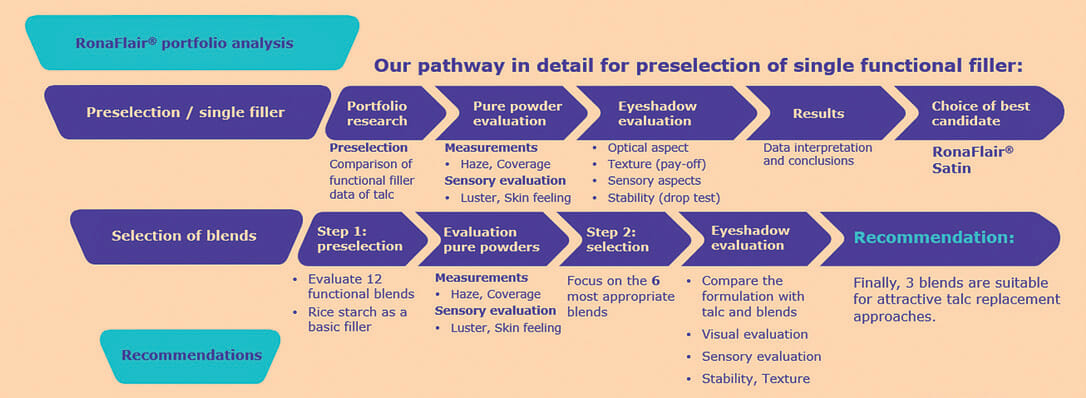
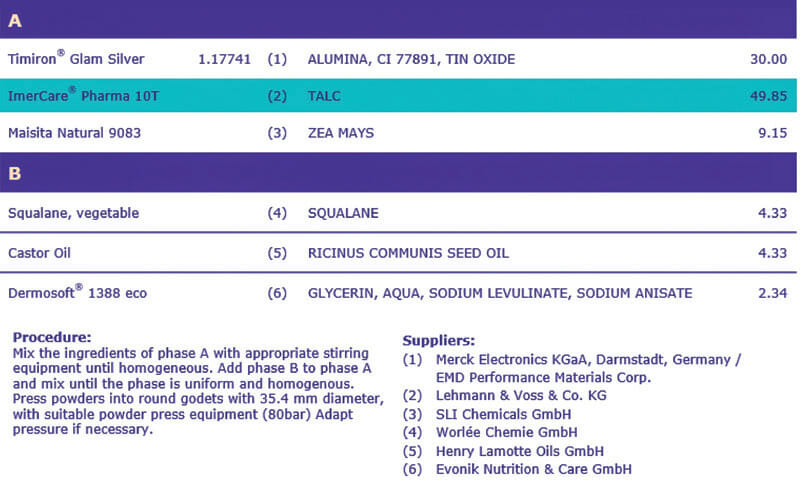
Materials and Methods
Materials
The materials used in this study were RonaFlair® Mica M, RonaFlair® White Sapphire, RonaFlair® Satin, RonaFlair® ESQ, RonaFlair® Boroneige SF15, RonaFlair® SynMica M (from Merck Electronics KGaA, Germany). Reisita Natural 9094, Imerys Talc Pharma 10T (as talc reference). For the optical evaluation the nail lacquer base 12897 from International Lacquers S.A. was used. The materials used for the eye-shadow formulation were: Maisita natural 9083, Squalene vegetable, Castor oil, Dermosoft 1388 eco (see Fig. 3 for details).
Methods
The optical properties of the single basic filler and functional fillers plus the blends were measured with the BYK-Gardner haze-meter. These investigations allow the detection of haze-clarity-transmission relationships, which give finally information about the soft-focus properties. With the Texture analyzer TA.XTPlus the texture of the eyeshadow formulation has been assessed through the penetration test performed with the texture analyzer TA.XTPlus. Cake strength and hardness of the pressed powder sample was measured.
The Drop test helped to evaluate the impact of different functional fillers and the stability of pressed eyeshadows.
Skin feel, coverage, pay off and shine evaluation were performed by experts and the above properties were ranked on a scale of 1 to 5, with 1 is the best performance in the evaluated property and 5 indicating the lowest of each category.
Application information
The nature-derived eyeshadow formulation (PPF) with 30% of pearlescent pigment and almost 50% of talc (systematically replaced by fillers or blends of fillers), was used for all pressed eyeshadow powder application evaluations (Fig. 3). A benchmark sample with talc was formulated. At that stage, a sample with rice starch was created as well, to evaluate its properties in pressed powders application as preliminary investigation before evaluating it in mixture with other fillers.
Alternative functional fillers with add-on benefits
The evaluation of single functional fillers as powder and in eyeshodow formulation depicts as best alternative to talc RonaFlair® Satin (INCI: Illite). Like talc, RonaFlair® Satin is a natural platy mineral. It is one of our most transparent fillers and has relatively low perceivable impact on the texture and other properties of formulations, compared to our other functional fillers. This makes it a valuable alternative. RonaFlair® Satin represents an off-white powder with a particle size < 25.0 μm, with low luster and coverage plus a soft, velvety feel.
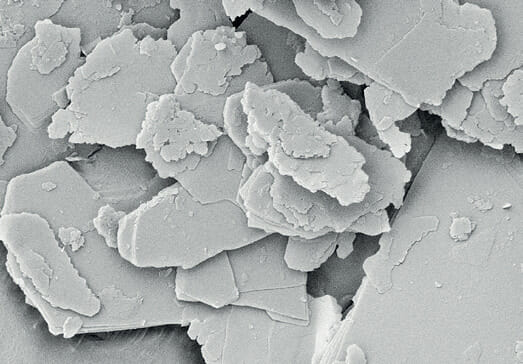


RonaFlair® Satin provides a more smooth and gliding skin feeling than talc, making it attractive for color cosmetics like lipsticks or eyeshadow. High amounts of color pigments can negatively affect texture and application properties of the latter. In pressed eyeshadows, it provides a good anti-caking effect which leads to a better pay-off compared to talc. It is especially effective in matte eyeshadow shades, which typically contain large amounts of dull, rougher inorganic colorants. Thus, it leads to a more satiny, smooth, and homogenous application.
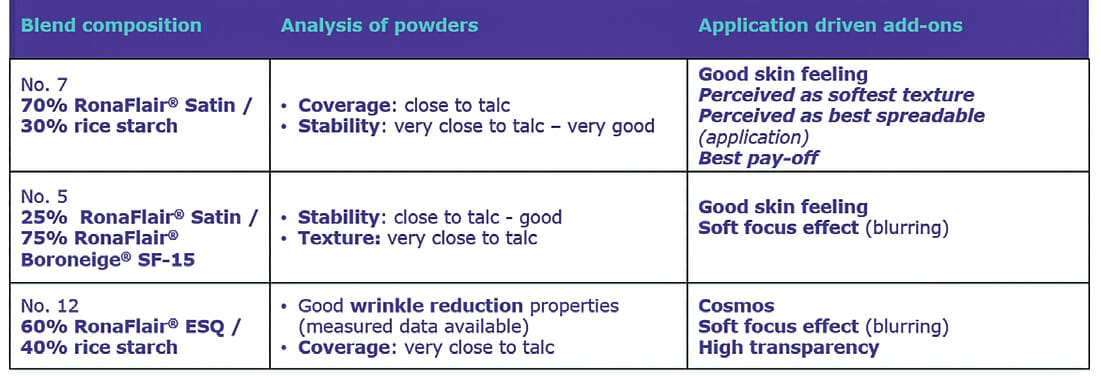
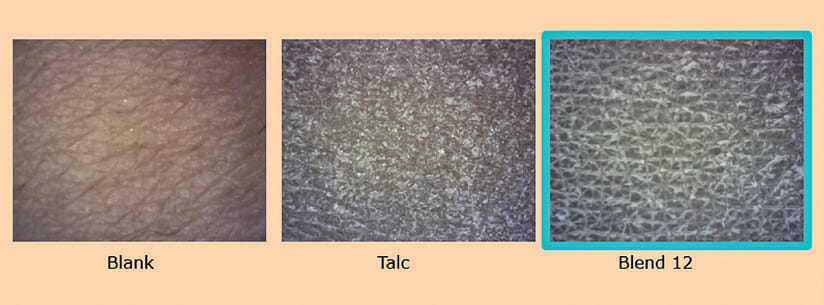
The most attractive blends of RonaFlair® Functional Fillers are depicted in table 1.
Blend no. 7, the most favored blend, composed of 70% RonaFlair® Satin/30% rice starch enriches this application with an excellent pay-off and spreadability, a soft texture plus offering coverage and stability closest to talc.

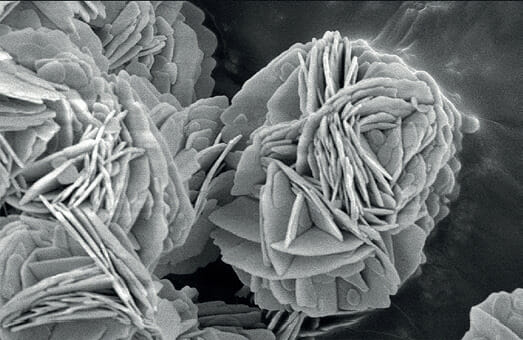
Summary
In summary, talc alternatives for attractive market products were identified. The comprehensive analysis of pure functional filler systems as well as selected blends thereof, taking into account the RonaFlair® Functional Filler portfolio, was studied. It suggests that in selected cosmetic applications the alternative RonaFlair® Satin and e.g. the blend with RonaFlair® Boroneige® SF15 are attractive options in terms of properties such as skin feel, coverage, stability and texture. Crystallographic similarities of talc, Illite and boron nitride were explored and support the rationale for the talc substitution. Furthermore, it can be emphasized that depending on the application focus, other functional fillers from the
RonaFlair® Functional Filler portfolio could also be considered as talc alternatives too. Taking into account the properties of skin feel and coverage or other aspects, the fillers RonaFlair® ESQ can be listed as further suitable choice.
References
- Asbestos in commercial cosmetic talcum powder as a cause of mesothelioma in women; Ronald E Gordon, Sean Fitzgerald, and James Millette; Int. J Occup. Envir. Health; 20(4): 318–332; 2014 Oct
- Talc (Mg3H2(SiO3)4); Echa.europa.eu website
- Talc; FDA .gov. website; Dec. 2022
- International Forum for Respiratory Research, Volume 34, 2022 – Issue 5-6, https://www.tandfonline.com/doi/full/10.1080/08958378.2022.2053251?scroll=top&needAccess=true&role=tab
- Clay mineral; Ralph E.Grim, Hideomi Kodama, The Editors of Encyclopaedia Britannica; Encyclopaedia Britannica
- Molecular Explanation for Why Talc Surfaces Can Be Both Hydrophilic and Hydrophobic Benjamin Rotenberg, Amish J. Patel, David Chandler; J. Am. Chem. Soc., 133, 50, 20521–20527; 2011
- Talc as friction reducing additive to lubricating oil; Pavlo Rudenko, Amit Bandyopadhyay; Applied surface science, volume 276, pages 383-389, 1 July 2013
- Boron nitride as a lubricant additive; Yoshitsugu Kimura a, Toshiaki Wakabayashi a, Kazumi Okada b, Tetsuya Wada c, Hiroshi Nishikawa d; Volume 232 issue 2, Pages 199-206 October 1999,
- Boron Carbide, Boron Nitride, and Metal Borides; Jochen Greim, Karl A. Schwetz; Ullmann’s Encyclopedia of Industrial Chemistry; December 2006
- 1Mica; R.V.Dietrich, The Editors of Encyclopaedia Britannica; Encyclopaedia Britannica
- Illite; The Editors of Encyclopaedia Britannica; Encyclopaedia Britannica
- The Role of H3O+ in the Crystal Structure of Illite; Fernando Nieto, Marcello Mellini & Isabel Abad; Clays and Clay Minerals volume 58, pages238–246, 2010


